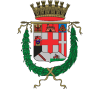The Basilica di Santa Maria del Carmine is popularly known as I Carmini, after the name of a monastic order which became established in Padua towards the end of the thirteenth century. The first church here was built in 1212, together with a convent, which was then rebuilt by the Carmelite Fathers.
The new church, dedicated to Santa Maria del Carmine, was consecrated in 1446. But then, in 1491, an earthquake led to the collapse of the wooden roof; work began immediately on rebuilding the existing structure, and evidence of that work can be seen in the succession of pilasters and chapels within it.
Another earthquake, in 1696, destroyed the vault over the nave, and rebuilding work ended only in the eighteenth century; then a fire in 1800 damaged the cupola.
The present facade, designed by Giovanni Gloria, dates from that rebuilding work and comprises a central portal decorated with tympanum and three statues sculpted by Giovanni Bonazza. The main doors are the oldest wooden doors in Padua (1412) and are divided into small square panels, each adorned with an acanthus leaf. The majestic interior comprises a single nave with a high cupola and has six side chapels along its length On the high altar, alongside the two statues of Angels by the Paduan sculptor Rinaldo Rinaldi, there is a fresco of the Madonna dei Lumini [lamps] by Stefano d’Arzere. This image was brought here by the people of Padua as a votive offering to implore the end of the plague, and the Feast of the Madonna dei Lumini is still an occasion of popular devotion nowadays. The church also houses an important work by Alessandro Varotari (known as ‘Il Padovanino’): the altarpiece of Christ and the Mother of Zebedei.
- DISCOVER
- LIVE
FOCUS
- GET INSPIRED
FOCUS
- INFO
- BOOK NOW












